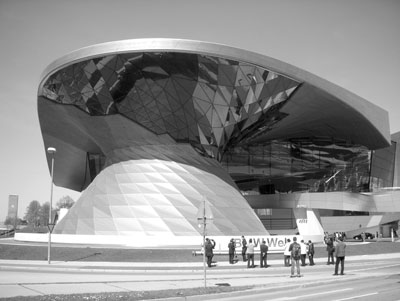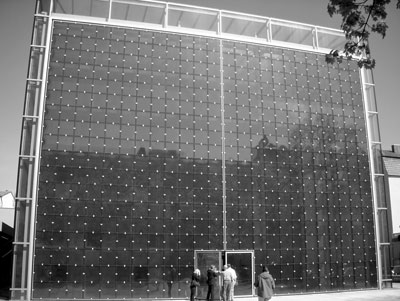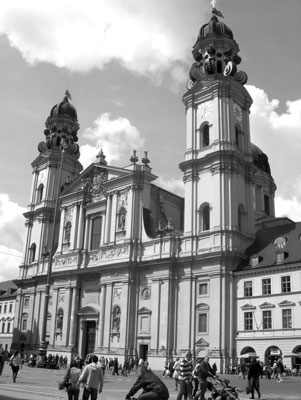New in Munich
This item appears on page 66 of the September 2008 issue.
by Jay Brunhouse
When I learned German in Munich, Germany (München), in 1966-67, Munich was known as The World City with Heart and The Secret Capital of Germany.
The most beautiful Christmas tree that I have seen nearly touched the ceiling in the center of the Munich main train station. This year when I heard news of GermanRail’s planned remodeling of the station into a shopping-mall-cum-trains, I asked, “Why?”
The present Munich Hauptbahnhof (main train station) is large, efficient and modern. All on ground level, it has an excellent tourist office for hotel bookings, a reputable hotel, mechanized luggage storage, a clean waiting room and the aroma of grilling sausages wafting through the departures hall.
I can point out how the platforms have been extended and facilities added since I first admired the Christmas tree and where engineers have added underground stations for rapid-transit (e.g., to the airport) and subway trains (e.g., to Arabella Park hotels).
Now Munich is known by the slogan “Munich Loves You” and is a bustling, booming, high-tech city — but still with heart.
Münchners have it good. It is the third-largest city in Germany. The neo-Gothic New Town Hall remains, and visitors still gawk at its animated Glockenspiel (carillon) and students still raise their mugs in the Hofbräuhaus beer hall, but new, architecturally splendid attractions and much more to see make Munich an even stronger 5-star visitor destination and place to stay. Its hotel rates are the highest in Germany but about half of those of every other major European center.
New attractions
On March 22, 2007, the 9,700-square-foot, $18-million New Jewish Museum funded by the City of Munich opened between the Jewish Community Center and Synagogue Ohel Jakob at Sankt-Jakobs-Platz.
Within the stone-faced cubic building designed by Saarbrücken architects you find the permanent exhibition of Munich’s Jewish history as well as changing exhibitions, a learning center, a library and a café.
The synagogue, built a year earlier, stands alone in the square. Its foundation clad in natural stone is reminiscent of the Temple of Jerusalem. The transparent glass superstructure with supports of steel recalls a concatenate Star of David. Inside, cedar wood from Lebanon and stone from Israel are the dominant materials.
Opened in 2000, the modern Herz Jesu Kirche (Church of the Sacred Heart) features a startling façade entirely of blue glass, which is opened in summers for concerts and celebrations.
In September 2002, the Pinakothek (museum) der Moderne joined its world-class predecessors in Munich’s museum quarter. The Alte Pinakothek, famous for its masterpieces from the golden ages of Europe, and the Neue Pinakothek, with paintings and sculptures from neo-classicism, Romanticism, Jugenstil and Impressionism, still face one another, but across Barer Straße from the Alte Museum the Architect Stephan Brunfels’ Pinakothek der Modern is of a size comparable to the Pompidou Center in Paris and the Tate Modern Museum in London.
The great museum presents four major collections in spacious surroundings under one roof. Visitors flock to the collections of modern art, works on paper, architecture and design.
Ultimate driving machines
On June 21, 2008, the BMW Museum reopened at truly spectacular BMW Welt (World), which had opened on Oct. 17, 2007. BMW Welt is an awesome work in the shape of a transparent, rounded and otherworldly flying saucer.
The museum, which is shaped like a mushroom with a spiral ramp to the top, displays 120 of the most significant BMW products, such as race and prototype cars, motorcycles and engines.
The 2002 Mercedes-Benz Center also receives high marks but can’t compare with BMW World. Together with a 200-foot elliptical glass tower, the completely glass structure looks like a block-long display window with about 70 models ready for inspection.
Across the highway from BMW World, the curving roofs of Munich’s Olympic Stadium provide the venue for sporting events, rock concerts and important congresses such as the marketplace and workshop of the 2008 German Travel Mart (GTM), April 27-29. Every year a different city hosts this travel event.
In Munich, about 350 exhibitors from the German travel industry and more than 600 buyers and journalists from 42 countries attended the marketplace where German companies showcased their products and services.
The largest delegation of international buyers was from the U.S., with 51 travel industry representatives and journalists. The UK followed in second place with 46, then Japan, which sent 41 people. Next were China and Hong Kong, with 39 representatives involved in tourism or media.
GTM held their official opening at Munich’s splendid National Theater (Opera House) and “Residenz München,” which was until 1918 the seat of government and residence of the Wittelsbach dynasty. As dukes, electors and, finally, kings, the Wittelsbachs developed their residence from a small, moated castle begun in 1385 to an extensive complex built around 10 courtyards.
The Residenz was extensively damaged by Allied bombing during the Second World War and, even yet, restoration is continuing, so only part of the Residenz is open to the public.
The Court Garden, begun in 1613, however, is open to everyone and is a delightful green oasis of green lawns, garden paths and bubbling fountains in the heart of Munich. It is very much Romantic.
Restoration reinstated the original paths and the tree arrangement of 1776. Landscape architects restored the strip of garden behind the restored 1816 gate and directly in front of the Residenz to its 1853 appearance, featuring the flower beds typical of that time. The 16th-century waterworks have also been restored and once more provide the fountains with water.
Many thanks
I thank the German National Tourist Office (New York, NY; 800/651-7010 or 212/661-7200, www.cometo germany.com) for inviting me to the GTM. American journalists stayed at the Arabella Sheraton Grand Hotel (now the Westin Grand Hotel Arabella Park), with rates from €138 (near $217).
Transportation was by Lufthansa, which has nonstop flights to Munich from many U.S. gateways. Notable is the nicely upgraded interiors of the Boeing 747 aircraft to Frankfurt.



